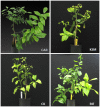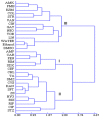Effective antibiotics against 'Candidatus Liberibacter asiaticus' in HLB-affected citrus plants identified via the graft-based evaluation
- PMID: 25372135
- PMCID: PMC4220982
- DOI: 10.1371/journal.pone.0111032
Effective antibiotics against 'Candidatus Liberibacter asiaticus' in HLB-affected citrus plants identified via the graft-based evaluation
Abstract
Citrus huanglongbing (HLB), caused by three species of fastidious, phloem-limited 'Candidatus Liberibacter', is one of the most destructive diseases of citrus worldwide. To date, there is no established cure for this century-old and yet, newly emerging disease. As a potential control strategy for citrus HLB, 31 antibiotics were screened for effectiveness and phytotoxicity using the optimized graft-based screening system with 'Candidatus Liberibacter asiaticus' (Las)-infected citrus scions. Actidione and Oxytetracycline were the most phytotoxic to citrus with less than 10% of scions surviving and growing; therefore, this data was not used in additional analyses. Results of principal component (PCA) and hierarchical clustering analyses (HCA) demonstrated that 29 antibiotics were clustered into 3 groups: highly effective, partly effective, and not effective. In spite of different modes of actions, a number of antibiotics such as, Ampicillin, Carbenicillin, Penicillin, Cefalexin, Rifampicin and Sulfadimethoxine were all highly effective in eliminating or suppressing Candidatus Liberibacter asiaticus indicated by both the lowest Las infection rate and titers of the treated scions and inoculated rootstock. The non-effective group, including 11 antibiotics alone with three controls, such as Amikacin, Cinoxacin, Gentamicin, Kasugamycin, Lincomycin, Neomycin, Polymixin B and Tobramycin, did not eliminate or suppress Las in the tested concentrations, resulting in plants with increased titers of Las. The other 12 antibiotics partly eliminated or suppressed Las in the treated and graft-inoculated plants. The effective and non-phytotoxic antibiotics could be potential candidates for control of citrus HLB, either for the rescue of infected citrus germplasm or for restricted field application.
Conflict of interest statement
Figures



References
-
- Bové JM (2006) Huanglongbing: a destructive, newly-emerging, century-old disease of citrus. Plant Pathol 88: 7–37.
-
- Garnier M, Bové JM, Jagoueix-Eveillard S, Cronje CPR, Sanders GM, et al.. (2000) Presence of “Candidatus Liberibacter africanus” in the Western Cape Province of South Africa. IOCV, Riverside, CA.
-
- Texeira DC, Ayres J, Kitajima EW, Danet L, Jagoueix-Eveillard S, et al. (2005) First report of a huanglongbing-like disease of citrus in São Paulo State, Brazil and association of a new Liberibacter species, “Candidatus Liberibacter americanus”. with the disease. Plant Dis 89: 107–107. - PubMed
-
- Halbert SE, Manjunath KL (2004) Asian citrus psyllids (Sternorrhyncha:Psyllidae) and greening disease of citrus: a literature review and assessment of risk in Florida. Fla Entomol 87: 330–353.
-
- Lin KH (1956) Observation on yellow shoot of citrus. Etiological study of yellow shoot of citrus. Acta Phytopathol Sin 2: 1–42.
Publication types
MeSH terms
Substances
LinkOut - more resources
Full Text Sources
Other Literature Sources
Medical
Research Materials

